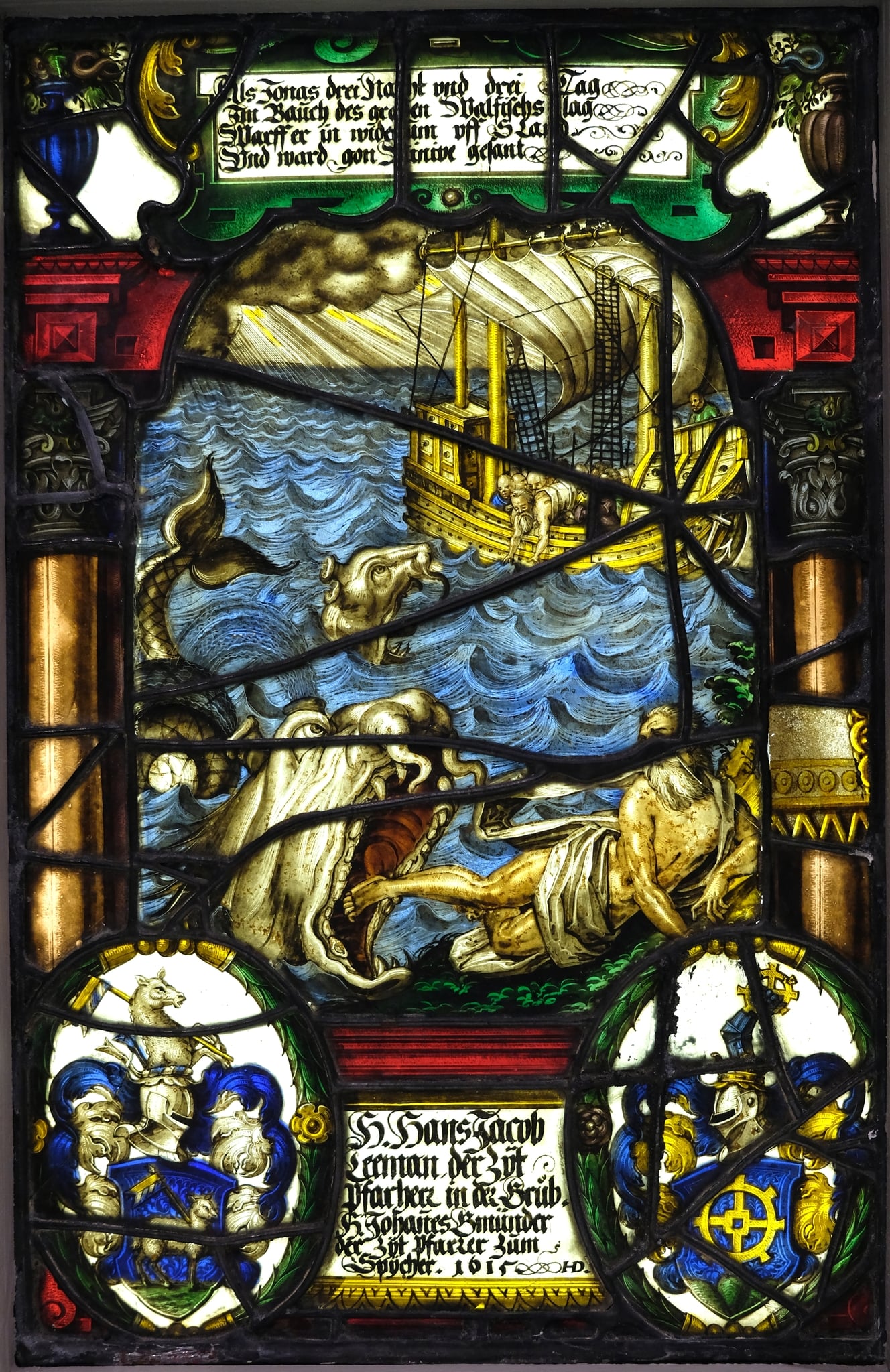The panel was given by donors from the towns of Grub and Speicher, located in Ausserrhoden, about six and a half km (four miles) from each other in the Protestant section of the canton of Appenzell. Appenzell is on the northeastern portion of Switzerland, with the canton of St. Gallen between it and the Austrian border. The Reformation reached the area swiftly in 1522 through the followers of Martin Luther and Ulrich Zwingli. Of greatest influence was the scholar, physician, and reformer Joachim von Watt, originally from St. Gallen. The principle of self-determination in religion was reached by municipal accord in 1525 and in 1529 all by one of the towns in Ausserrhoden, had sided with the Reformation. These prosperous farming towns were small; in 1667, the population of Speicher was recorded at 908 and that of Grub at 543. For the individuals named, Hans Jakob Lehman was a pastor originally from Zürich but Johannes Gmünder was from Appenzell itself. The larger cities in Switzerland often had an excess of trained ministers who moved to remote cantons to serve as clergy for smaller towns (Koller, & Signer, 1926, IX).
The signature can be identified as that of Hans Denzler (Boesch, 1955b, pp. 43, 46). Denzler is documented as active in Zürich, until his death around 1647 (Mayer, 1884, p. 238). He is known for many commissions from the Protestant cantons of Appenzell and St. Gallen. There were great similarities among the workshops in each of these cantons. Denzler’s style and the composition recalls those of Hans Jegli (1579–1643) active in Winterthur. Compare the 1615 panel by Jegli of the meeting between Abigail and David (Boesch, 1955a, p. 42, fig. 11)
The Old Testament describes Jonah being called by God (Jonah 1) to preach to the inhabitants of Nineveh, in present-day northern Iraq. Seeking to flee from this daunting task, Jonah set out to sea in a ship from the port of Jaffa almost 800 miles away. The Lord caused a great storm and the sailors cast lots to see who was the cause of divine displeasure. The lot fell on Jonah, who admitted his transgression, and he was cast into the sea. The Lord sent a “great fish to swallow up Jonas: and Jonas was in the belly of the fish three days and three nights” (Jonah 2:1). During this time, he prayed until the fish “vomited out Jonas upon the dry land” (Jonah 2:11). The story of Jonah and the whale has been an essential part of Christian thought since the earliest centuries. Christ himself cited it as a symbol of his resurrection, saying “as Jonah was in the whale’s belly three days and three nights; so shall the son of man be in the heart of the earth three days and three nights” (Matthew 12:40). In the later Middle Ages, it was a part of typological codification of the Biblia Pauperum, which saw early printing in the 15th century (Henry, 1987, p. i).
Princeton’s panel appears to have been based on two prints of the subject by Jost Amman, originally from Zurich, who relocated by 1561 to Nuremburg where he became one of the most prolific illustrators of his time. An early work was Neuwe biblische Figuren dess Alten und Neuwen Testaments of 1565 (Amman, 1565). The book of about 140 images with labels in Latin and German marks Amman’s position as the premier illustrator for the Frankfurt publisher Sigmund Feyerabend (1528–1590). The wide dissemination of the 1565 publication is shown by the image of Jonah and the Whale copied in the 1579 Heraldic Representation of the city of Glarus in the Cloister of Wettingen (Ost VIIa; Hoegger, 2002, pp. 182, 382–83). In 1571, Feyerabend published a full text of Luther’s biblical translation with Amman’s illustrations (Amman, & Weis, 1571). The illustration from the Bible of 1571 is closest to the Princeton image of Jonah. Amman presents the huge mouth of the whale and great curving body in the very forefront of the composition. The boat, however, seems closer to the disposition in the 1565 picture book. The whale is shown a second time, as in the Princeton panel, about to swallow Jonah.
One of the most sophisticated of Swiss glass designers, Christoph Murer, executed a drawing dated around 1600, based on Amman’s engraving (Ruoss, & Giesicke, 2012, p. 565, fig. 599). The drawing is more dramatic, giving greater detail to the gaping mouth of the whale. This sketch may have exerted a direct influence on the Princeton panel. Jonah assumes a similar position on the beach, leaning on his left forearm as he looks back at the whale. The whale’s marvelous waterspout and tentacles extending from the nostrils are also identical. Workshops apparently shared imagery and/or artists copied preparatory sketches and finished panels. Thus, we find a drawing for a heraldic panel by Hans Jakob Nüscheler, dated 1627, with three coats of arms, and an exact replication of Murer’s drawing from a generation earlier (Ruoss, & Giesicke, 2012, p. 565, fig. 600). A panel associated with the Nüscheler workshop and dated 1647 repeats the exact disposition of the drawing and adds Fischart’s typological text (St. Petersburg, Hermitage Museum, no. B 220; Shlikevich, 2010, pp. 150–51, no. 58). A composite panel now in the Gotische Haus in Wörlitz, Germany, contains an almost intact central segment showing Jonah that must have been executed after the Murer or Nüscheler drawings. The date is estimated to be between 1600 and 1650 (Ruoss, Giesicke, 2012, pp. 564–67, no. XXX, 7, Abb. 121).
Cited in:
Record Art Museum, 1963, p. 19.
Raguin, & Morgan, 1987, p. 84.
Raguin, 1987, pp. 48–49, no 13.
Raguin, 1998, pp. 57–58, 63–65, fig. VII.4.
